Canis Major is a constellation in the southern sky. Its name means “the greater dog” in Latin. Canis Major represents the bigger dog following Orion, the hunter in Greek mythology. The dog is often depicted pursuing a hare, represented by the constellation Lepus. The smaller dog is represented by the neighboring constellation Canis Minor.
Both dog constellations are among the 48 Greek constellations, first catalogued by Claudius Ptolemy of Alexandria in his Almagest in the 2nd century CE.
Canis Major is home to Sirius, the brightest star in the sky, as well as to several notable deep sky objects: the Canis Major Dwarf Galaxy, the open cluster Messier 41, the emission nebula NGC 2359 (also known as Thor’s Helmet), and the colliding spiral galaxies NGC 2207 and IC 2163.
Facts, location and map
Canis Major is the 43rd biggest constellation in the sky, occupying an area of 380 square degrees. It is located in the second quadrant of the southern hemisphere (SQ1) and can be seen at latitudes between +60° and -90°. The neighboring constellations are Columba, Lepus, Monoceros, and Puppis.
The constellation name Canis Major is pronounced /ˈkeɪnɪs ˈmeɪdʒər/. In English, the constellation is known as the Great Dog. The genitive form of Canis Major, used in star names, is Canis Majoris (pronunciation: /ˈkeɪnɪs məˈdʒɒrɪs/). The three-letter abbreviation, adopted by the International Astronomical Union (IAU) in 1922, is CMa.
Canis Major belongs to the Orion family of constellations, along with Canis Minor, Lepus, Monoceros, and Orion.
Canis Major contains one Messier object, the star cluster Messier 41 (NGC 2287), and has four stars with known planets. The brightest star in Canis Major, Sirius (Alpha Canis Majoris), is also the brightest star in the night sky. There are no meteor showers associated with the constellation.
Canis Major contains 10 formally named stars. The star names approved by the International Astronomical Union (IAU) are Adhara, Aludra, Amadioha, Atakoraka, Furud, Mirzam, Muliphein, Sirius, Unurgunite, and Wezen.
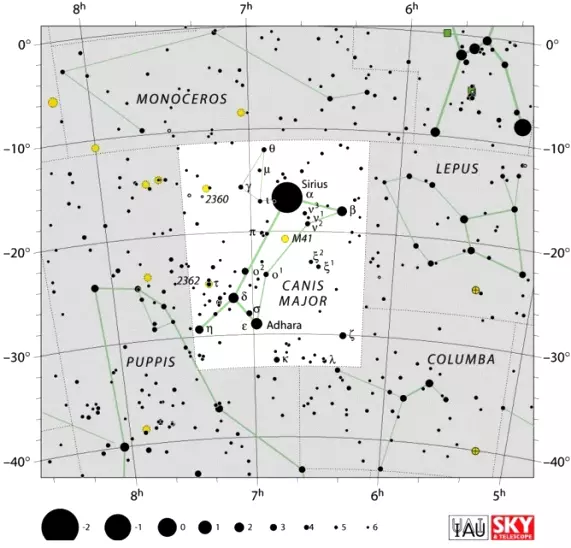
Canis Major constellation map by IAU and Sky&Telescope magazine
Myth
Canis Major is commonly taken to represent the “greater dog” following the hunter Orion in Greek myth. The constellation is depicted as a dog standing on its hind legs, pursuing a hare, represented by the constellation Lepus.
Canis Major was described by Manilius as “the dog with the blazing face” because the dog appears to hold Sirius, the brightest star in the sky, in its jaws.
In mythology, Canis Major is associated with Laelaps, the fastest dog in the world, one destined to catch anything it pursued. Zeus gave Laelaps to Europa as a present, along with a javelin that could not miss. The gift proved to be an unfortunate one, as Europa herself met her end at the hands of her husband Cephalus, who was out hunting with the javelin.
Cephalus took the dog to Thebes in Boeotia (a Greek province north of Athens) to hunt down a fox that was causing some trouble there. Like Laelaps, the fox was very fast and was destined never to be caught. Once the dog found the fox and started chasing it, the race did not appear to have an end in sight. Zeus himself finally ended it and turned both animals to stone. He placed the dog in the night sky as the constellation Canis Major.
Canis Major stars
Sirius – α Canis Majoris (Alpha Canis Majoris)
Sirius, also known as the Dog Star, is the brightest star in the sky and the fifth nearest star system to the Sun. Sirius is a binary star with an apparent magnitude of -1.42. It is only 8.6 light years distant.
The brighter component, Sirius A, is a white main sequence star and the companion, Sirius B, is a white dwarf that orbits the primary every 50 years. The distance between the two stars varies between 8.1 and 31.5 astronomical units. The companion is not visible to the unaided eye.
Sirius A belongs to the spectral class A1V, and the dwarf to DA2. Sirius A has twice the mass of the Sun and is 25 more luminous. Sirius B is almost equal to the Sun in mass (0.98 solar masses) and is one of the most massive white dwarfs known.
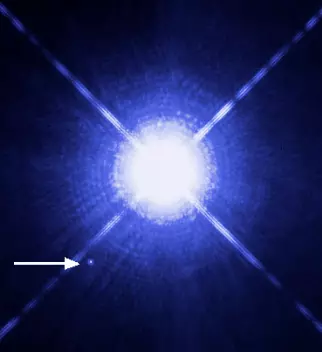
Sirius A and Sirius B, image: Hubble Space Telescope, credit: ESA, NASA, H. Bond (STScI) and M. Barstow (University of Leicester)
Sirius A has an absolute visual magnitude of 1.42 and Sirius B, 11.18. The age of the star system is estimated to be between 200 and 300 million years.
The name Sirius comes from the Greek Σείριος (Seirios), which means “scorching,” “glowing” or “searing.” In ancient times, the star rose just before sunrise during the hottest summer period, the so-called Dog Days. Greeks and Romans believed the star was somehow responsible for the summer heat.
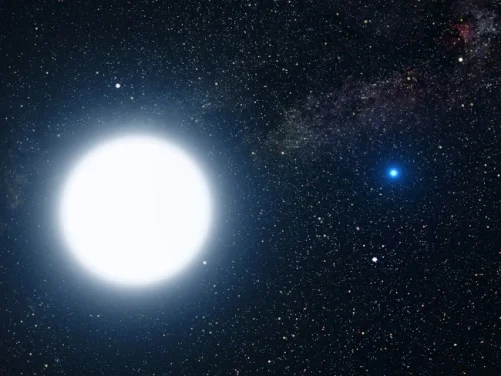
This picture is an artist’s impression showing how the binary star system of Sirius A and its diminutive blue companion, Sirius B, might appear to an interstellar visitor. The large, bluish-white star Sirius A dominates the scene, while Sirius B is the small but very hot and blue white-dwarf star on the right. The two stars revolve around each other every 50 years. White dwarfs are the leftover remnants of stars similar to our Sun. The Sirius system, only 8.6 light-years from Earth, is the fifth closest stellar system known. Sirius B is faint because of its tiny size. Its diameter is only 7,500 miles (about 12 thousand kilometres), slightly smaller than the size of our Earth. The Sirius system is so close to Earth that most of the familiar constellations would have nearly the same appearance as in our own sky. In this rendition, we see in the background the three bright stars that make up the Summer Triangle: Altair, Deneb, and Vega. Altair is the white dot above Sirius A; Deneb is the dot to the upper right; and Vega lies below Sirius B. But there is one unfamiliar addition to the constellations: our own Sun is the second-magnitude star, shown as a small dot just below and to the right of Sirius A. Image: NASA, ESA. Credit: G. Bacon (STScI)
In Egypt, Sirius marked the flooding of the Nile. The star’s heliacal rising, just before the annual flooding and the summer solstice, played a crucial role in the Egyptian calendar during the Middle Kingdom era.
Along with the stars Rigel in Orion, Aldebaran in Taurus, Capella in Auriga, Pollux/Castor in Gemini, and Procyon in Canis Minor, Sirius forms the Winter Hexagon (or Winter Circle) asterism, which appears prominently in the northern sky between December and March.
Sirius is also part of the Winter Triangle (or the Great Southern Triangle), together with Procyon in Canis Minor and Betelgeuse in Orion constellation.
Adhara – ε Canis Majoris (Epsilon Canis Majoris)
Adhara is the second brightest star in Canis Major and the 24th brightest star in the night sky. Its name comes from the Arabic aðāra, which means “virgins.” It is a binary star that lies about 430 light years from Earth.
The primary component belongs to the spectral class B2 and has an apparent magnitude of 1.5. It is one of the brightest known ultraviolet sources in the sky. The companion star has an apparent magnitude of 7.5 and is located 7.5’’ away from the primary.
About 4.7 million years ago, Adhara was the brightest star in the sky. It was only 34 light years distant and had a magnitude of -3.99. No other star has ever been as bright since, nor is one expected to be in the next five million years.
Wezen – δ Canis Majoris (Delta Canis Majoris)
Wezen is a yellow-white F-type supergiant approximately 1,800 light years distant. It has an apparent magnitude of 1.83. It is the third brightest star in Canis Major. Wezen can be found about 10 degrees southeast of Sirius. Its name is derived from the Arabic al-wazn“, meaning “the weight.” The star’s estimated age is 10 million years, which means that it will become a red supergiant within the next 100,000 years, and eventually a supernova.
Mirzam – β Canis Majoris (Beta Canis Majoris)
Mirzam (Al-Murzim, Murzim) is a blue-white giant with brightness varying between magnitude 1.95 and 2.00. It is approximately 500 light years distant. The star’s name comes from the Arabic word for “the herald,” presumably referring to Mirzam’s position in the sky. (The star rises before Sirius, i.e. it heralds it.)
Mirzam is classified as a Beta Cephei variable, a star that exhibits variations in brightness as a result of pulsations of its surface.
Aludra – η Canis Majoris (Eta Canis Majoris)
Aludra is an Alpha Cygni type variable star, with luminosity varying between magnitude 2.38 and 2.48. It is a blue supergiant, approximately 3,000 light years distant, and already approaching the final stages of its life. It is expected to become a supernova within the next few million years.
The star’s name is derived from the Arabic al-‘aðrā, meaning “the virgin.” Along with Adhara, Wezen and Omicron-2 Canis Majoris, Aludra was one of the stars known as the Virgins.
τ Canis Majoris (Tau Canis Majoris)
Tau CMa is an eclipsing spectroscopic binary star about 3,200 light years from Earth. It is the brightest star of the open cluster NGC 2362 (Caldwell 64), which is why the cluster is sometimes called the Tau Canis Majoris Cluster.
The star is an O-type blue supergiant classified as a Beta Lyrae type variable. Its brightness varies between magnitude 4.32 and 4.37 with a period of 1.28 days.
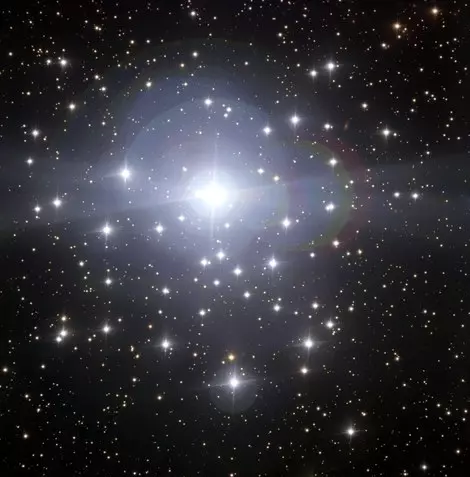
The Tau Canis Majoris Cluster is an open cluster — a group of stars born from the same molecular cloud. This means that all of the cluster’s inhabitants share a common chemical composition and are loosely bound together by gravity. Having been born together, they make an ideal stellar laboratory to test theories of stellar evolution, the chain of events that leads from a star’s birth in a cool, dense cloud of gas through to its eventual death. Though the stars in this image were all created at the same time, their various different masses mean they will lead very different lives. As Tau Canis Majoris is one of the most massive and short-lived types of star, it will burn through its nuclear fuel long before its smaller companions, which will keep on shining for billions of years. Image: ESO
Phurud – ζ Canis Majoris (Zeta Canis Majoris)
Phurud (or Furud) is a spectroscopic binary star. Its name comes from the Arabic phrase al-furud, which means “the solitary ones.” The star lies about 336 light years from Earth and has an apparent magnitude of 3.02.
The brighter component is a blue-white B-type main sequence dwarf. The companion is an unseen star. The two orbit around a common centre once every 675 days.
Muliphein – γ Canis Majoris (Gamma Canis Majoris)
Muliphein is a blue-white B-type bright giant approximately 402 light years distant. It has an apparent magnitude of 4.11.
Deep sky objects in Canis Major
Messier 41 (M41, NGC 2287)
M41 is an open cluster located four degrees south of Sirius. It is 25-26 light years in diameter and between 190 and 240 million years old.
The cluster contains about 100 stars, with the brightest one being a K3-type giant located near the centre of the cluster. M41 also contains several red giants.
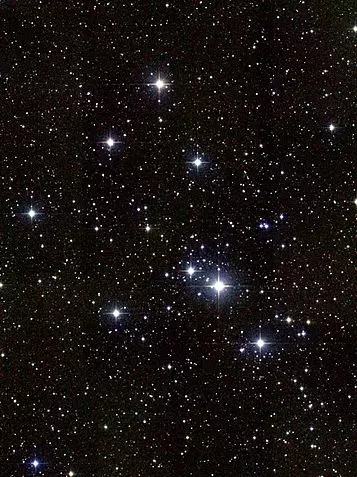
Messier 41 (NGC 2287), Atlas Image mosaic courtesy of 2MASS/UMass/IPAC-Caltech/NASA/NSF
The cluster is approximately 2,300 light years distant. It has an apparent magnitude of 4.5. It was discovered by the Italian astronomer Giovanni Batista Hodierna in the 17th century.
Canis Major Dwarf Galaxy
The Canis Major Dwarf Galaxy (CMa Dwarf) is an irregular galaxy, roughly elliptical in shape, that is believed to be the nearest neighbouring galaxy to the solar system. It is approximately 25,000 light years distant from Earth and 42,000 light years away from the Galactic Centre.
The Canis Major Dwarf Galaxy contains about a billion stars, among them a significant number of red giants. The galaxy was first discovered in 2003 by an international team of astronomers. It is a difficult object to observe because it lies behind the plane of the Milky Way, obscured by stars, dust and gas.
Because the galaxy’s main body is highly degraded, the Canis Major Dwarf is believed to be severely affected by the Milky Way’s gravitational field.
There are a number of globular clusters associated with the galaxy, among them NGC 1851, NGC 1904, and NGC 2808. These clusters are thought to be remnants of the dwarf’s globular cluster system before the galaxy started getting pulled apart and swallowed into the Milky Way.
NGC 2359 – Thor’s Helmet
NGC 2359 is an emission nebula in Canis Major. It is about 30 light years in size, and some 15,000 light years distant from Earth. The nebula is formed around the central Wolf-Rayet star, an exceptionally hot giant which will meet its end as a supernova.
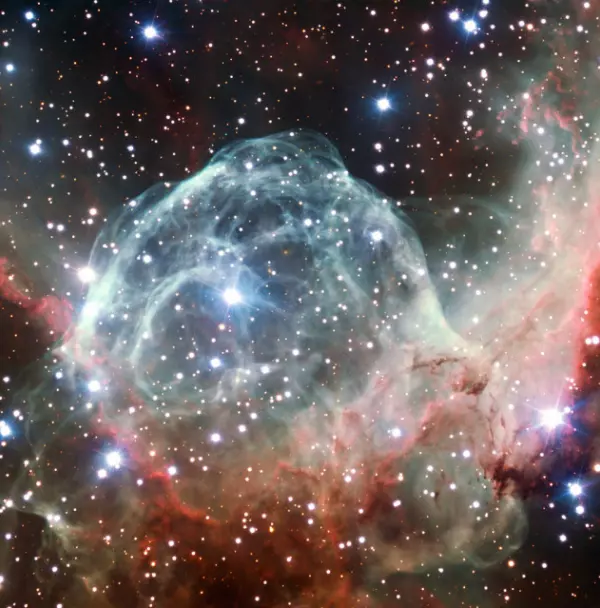
This VLT image of the Thor’s Helmet Nebula was taken on the occasion of ESO’s 50th Anniversary, 5 October 2012, with the help of Brigitte Bailleul — winner of the Tweet Your Way to the VLT! competition. The observations were broadcast live over the internet from the Paranal Observatory in Chile. This object, also known as NGC 2359, lies in the constellation of Canis Major (The Great Dog). The helmet-shaped nebula is around 15 000 light-years away from Earth and is over 30 light-years across. The helmet is a cosmic bubble, blown as the wind from the bright, massive star near the bubble’s centre sweeps through the surrounding molecular cloud. Image: ESO/B. Bailleul
NGC 2207 and IC 2163
NGC 2207 and IC 2163 are colliding spiral galaxies in Canis Major. They are approximately 80 million light years distant. The galaxies were discovered by the English astronomer John Herschel in 1835. They have apparent magnitudes of 12.2 and 11.6, respectively.
Three supernovae have been observed in NGC 2207 in recent decades; SN 1975A in 1975, SN 1999ec in 1999, and SN 2003H in 2003.
The galaxies are in the process of tidal stripping, with the larger galaxy pulling stars and other material from the smaller one.

Near colliding NGC 2207 and IC 2163 as seen by the NASA/ESA Hubble Space Telescope. Image: NASA/ESA and The Hubble Heritage Team (STScI)